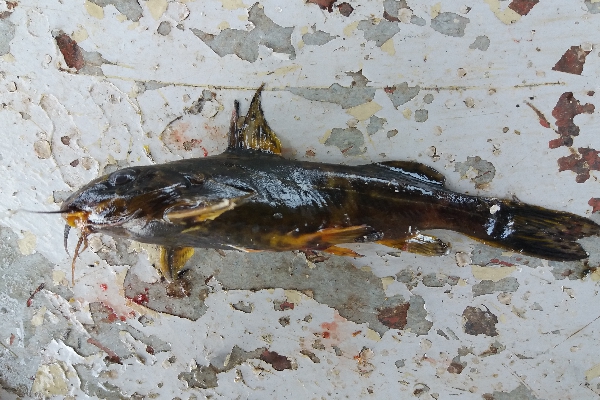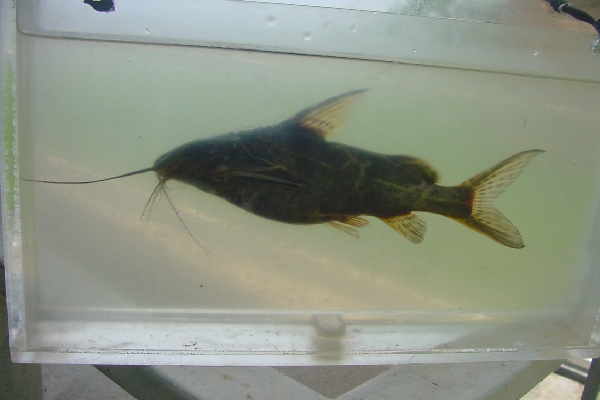Common names:
Fischer's Victoria squeaker
None
Taxonomic tree
Kingdom: Animalia
Phylum: Chordata
Class: Actinopterygii (ray-finned fish)
Order: Siluriformes (Catfish)
Family: Mochokidae (Squeakers or upside-down catfishes)
Genus: Synodontis
Species: Synodontis afrofischeri (Hilgendorf 1888)
Number of Occurrancies: 581
Etymology(based on Scharpf & Lazara, 2017)
- Synodontis: an ancient name for an undetermined fish from the Nile
- afrofischeri: afro-, referring to distribution in east Africa (type locality in Tanzania); fischeri, in honor of Gustav Adolf Fischer (1848-1888), who collected type material.
Synonyms: click here to view synonyms on FishBase
Type locality: Ukerewe (Kagehi or Kageyi, east of Kayenze, southern shore of Lake Victoria), Tanzania. Holotype at Zoologisches Museum Berlin (ZMB)
General identifcation features of family Mochokidae: Mochokidae is easily distinguished from other catfishes by the presence of branched mandibular barbels, and the absence of nasal barbels. Note that families Auchenoglanidae and Malapteruridae also lacks nasal barbles, but the mandibular barbles are not branched. Only one genus, Synodontis, occurs in Ugandan waters. Synodontis fishes have pectoral spine that is articulated by means of a complicated joint so arranged that the spine can be firmly locked into its erectile position. This spine can inflict a painful wound if not handled with care. Synodontis are refered to as talking fish because of the grunts and squeaks produced when the fish is taken out of water. The sounds are produced by the movement of the pectoral fin spine.
Distinguishing characters for the species:
- 32-54 mandibular teeth (diagnostic);
- Marbled yellow-brown colouration. The extent of marbling is variable, and uniformly brown fishes can be encountered. In many fishes, scattered dark spots occur on the body
- Body depth contained 3.5-4.5 times in standard length
- Maxillary barbels reaching almost to the origin of the pelvic fins in some fishes, and to the posterior tip of the humeral process in others
- Outer Mandibular barbels with slender branches, inner pair with shorter but slender branches
- Depth of the humeral process contained 1.5-2 times in its length
- Dorsal fin with a spine, smooth anteriorly and serrated on its posterior face, and 7 branched rays
- Distance between last dorsal fin ray and the origin of the adipose fin contained 1.33 times in the length of adipose fin
- Pectoral spine strongly serrated on its anterior face, very strongly serrated on the posterior face
Distribution in Uganda: Lake Victoria and its affluent rivers, Lakes Nabugabo and Kyoga, and the Victoria Nile
Occurence: Native
Habitat: Benthopelagic; in lakes, it is commmon at depths less than 30 m. It appears to be commoner in rivers than in the lake, where ot occurs in the marginal vegetation.
Feeding: Insects and molluscs. Insects dominate in the diet, especially chironomid larvae and povilla
Biology: Rarely grows beyond 15 cm standard length, but reaches 9 cm fork length (FL) after year 1. Generally more tha 50% of fishes in both sexes are mature at 9 cm FL. Sex ratio is biased towards more of males than females. Fecundity ranges between 200-15000 eggs. Spawning takes place throught the year; about 65% of the stock is contineously in spawning state.
Economic importance/End use: Seasonally abundant, but forms an important subsistence fishery.
IUCN conservation status: click here to view conservation status
Threats: Fishing, predation by Nile perch
Main references
- Greenwood PH. 1966. The fishes of Uganda. The Uganda Society, Kampala. 131 pages.
- Sharpf C, Lazara J.K. 2017. Fish Name Etymology Database v4. www.etyfish.org
- Witte F & van Densen W.L.T. 1995. Fish Stocks and Fisheries of Lake Victoria: a handbook for field observations. Samara Publishing Limited, Netherlands


